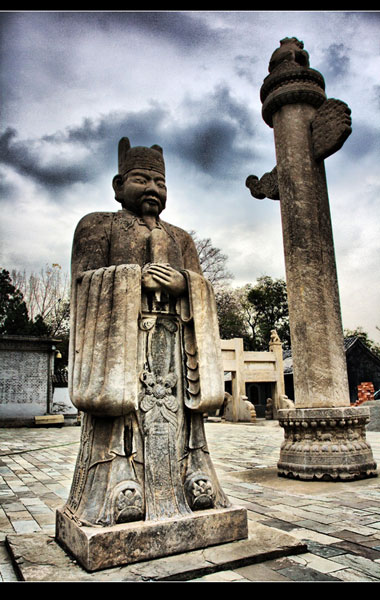Telephone: +86-10-88724148, 88722585
Address: 80 Moshikou Street, Shijingshan District, Beijing
Post Code: 100041
Admission: 8 yuan
|

|
|
The Tomb of Eunuch Tian Yi is on the west of Beijing, 20km from the downtown. As the largest eunuch tomb complex, the main tomb was built to salute the life of eunuch Tian, who served three generations of Ming emperors. He is the only eunuch who enjoyed grave complex similar to that of the Ming Emperors' Tombs: a sacred way with sculptures of horses, elephants, etc., and underground graves. Photo by Wangjifeixia/Fengniao.com.
|
Throughout the ancient world, eunuchs were a small stratum of society, most notably in China, Rome, Egypt, Greece, and Persia. Castration was a requirement of men seeking to work as imperial aides or entertainers. In most of these places, the practice diminished as the slave society declined. But in China, it lasted from the Xia Dynasty through to the Qing Dynasty in the early 20th century. During this time, a eunuch culture emerged, and in the Ming Dynasty (1368-1644), a bureaucratic system consisting of 12 directorates, four offices and eight bureaus was established. A eunuch named Tian Yi (1534-1605) oversaw the Directorate of Ceremonies, the highest office within the administration. His legacy is perhaps the most celebrated of all Chinese eunuchs.
In line with the practice of the time, Tian Yi was castrated at the age of nine and went to the imperial court to wait on the emperor and his entourage. He served three emperors -- Jiajing, who reigned from 1521 to 1566, Longqing, who reigned from 1566 to 1572, and Wanli, who reigned from 1572 to 1620. He was favored and promoted to the fourth rank because of his considerateness, cautiousness, experience and prudence. He died at the age of 72, having worked in the imperial court for 63 years. On Tian Yi's death, Emperor Wanli was so bereft that he suspended court meetings for three days and later erected a memorial hall and tablet pavilions to commemorate his good and faithful servant. In order to pay tribute to him, eunuchs of later generations had their tombs near his, forming the group that now constitutes the Beijing Eunuch Culture Exhibition Hall in Shijingshan District of Beijing. This is China's first museum to focus on the eunuch phenomenon. Its halls have exhibits that give insight into the history of the eunuch system, their duties, and their marital and family lives.
Tian Yi's mausoleum is the main body of the exhibition. As a favorite eunuch of the Ming emperors, it has all the features of an imperial mausoleum, although on a smaller scale. Behind the Divine Path Gate is a path leading to Tian Yi's tomb. The ornamental stone columns on both sides of the Divine Path are tall and exquisitely carved, and the stone warriors guarding his tomb are generals. The second entrance is Lingxing Gate, beyond which are three pavilions, each housing a stone tablet, recording Tian Yi's merits and achievements, and the imperial edict. Next is Shouyu Gate, regarded as a dividing line between the temporal and the netherworld. In ancient times this gate never opened, and sacrificial rituals were conducted in the memorial hall outside it. The tombs of Tian Yi and four other eunuchs are within Shouyu or the "netherworld." The tomb mounds and most of the sacrificial altars are carved from marble, because ancients regarded stone as lifeless, and wood as having life. Most tomb structures were therefore made of stone, while residences were wooden structures.
The most eye-catching feature of Tian Yi's mausoleum is its stone carvings. They vividly portray auspicious motifs, like dragons, lions and deer, and also plants like the Asiatic plantain and Ganoderma mushroom. Marble relief sculptures around the tombs depict ancient anecdotes, such as Sun Kang studying by the light of snow, Su Wu tending sheep, and Yang Xu hanging fish.
(China.org.cn November 11, 2008)